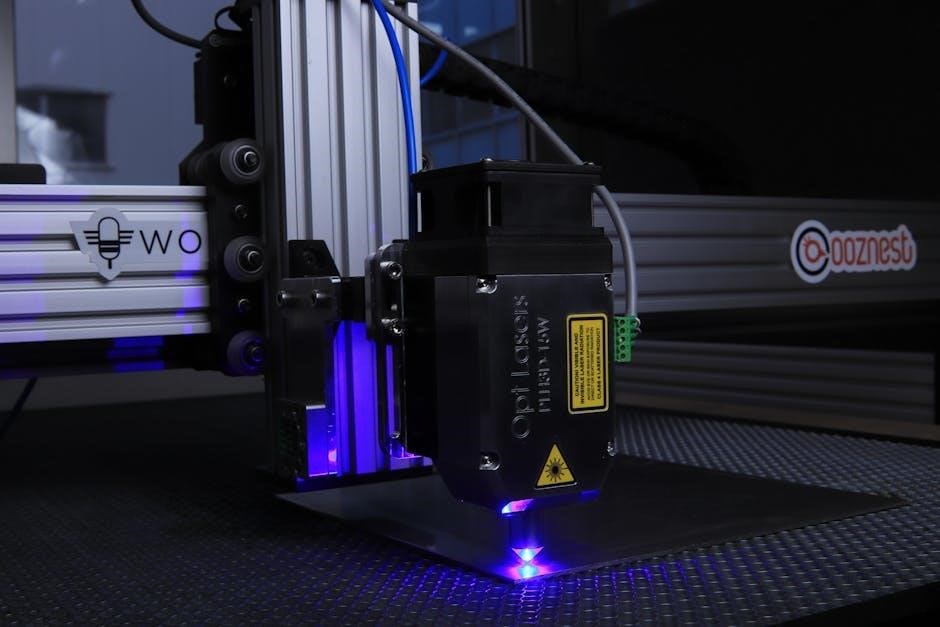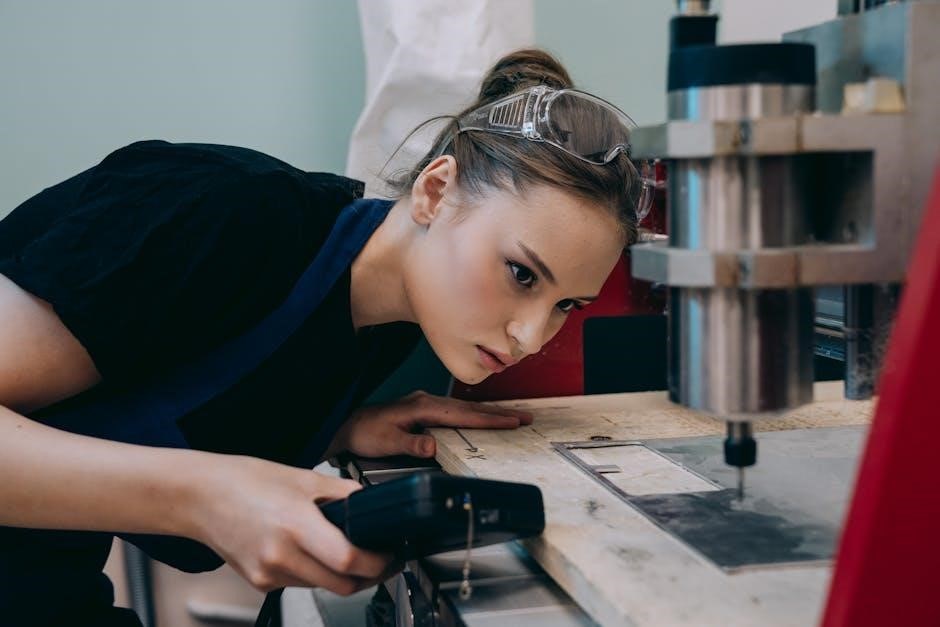Overview of Precision Machining Technology
Packed with detailed examples and illustrations, Precision Machining Technology, Third Edition, provides a comprehensive introduction to the machine tool industry, focusing on modern techniques and advancements.
The third edition of Precision Machining Technology offers a comprehensive update, incorporating the latest advancements in machine tool technology, cutting tools, and materials. Designed for students and professionals, it provides detailed insights into modern machining processes, with a focus on CNC machining and automation. This edition includes revised chapters on metrology and quality control, ensuring alignment with current industry standards. Enhanced with new illustrations and practical examples, it serves as an essential resource for understanding precision machining in today’s industrial landscape.
1.2 Key Features of the Book
The third edition of Precision Machining Technology is distinguished by its detailed examples, clear illustrations, and practical approach to learning. It covers fundamental concepts, advanced machining processes, and real-world applications, making it a valuable resource for both students and professionals. The book emphasizes CNC machining, automation, and metrology, ensuring readers are well-prepared for modern industry challenges. With a focus on hands-on learning, it includes case studies and best practices, offering a comprehensive understanding of precision machining technologies and their applications across various industries.
Fundamentals of Precision Machining
Precision machining relies on advanced machine tool technology, cutting tools, and materials to achieve high accuracy and surface finishes, supporting modern manufacturing and innovation in various industries.
2.1 Machine Tool Technology
Machine tool technology forms the backbone of precision machining, enabling the creation of high-precision components. Modern machine tools, such as CNC lathes, milling machines, and grinders, utilize advanced automation and software to ensure accuracy. These tools are designed to handle complex geometries and tight tolerances, making them essential for industries like aerospace and automotive. The integration of high-speed machining and multi-axis systems further enhances productivity and precision. Proper maintenance and calibration of machine tools are critical to achieving consistent results in precision machining applications.

2.2 Cutting Tools and Materials
Cutting tools and materials are crucial in precision machining, determining the accuracy and efficiency of the process. High-speed steel, carbide, and diamond-coated tools are commonly used for their durability and precision. Advanced materials like cubic boron nitride (CBN) and polycrystalline diamond (PCD) are employed for machining hard and abrasive materials. Tool geometry and coatings play a significant role in reducing wear and improving surface finish. The selection of appropriate cutting tools and materials ensures optimal performance, minimizing downtime and enhancing the quality of machined components. This chapter explores the latest advancements in cutting tool technology and material science, essential for modern machining applications.

Advanced Machining Processes
Advanced machining processes include CNC machining, automation, and additive manufacturing, enabling precise and efficient production of complex components with high accuracy and minimal material waste.

3.1 CNC Machining and Automation

CNC machining and automation are cornerstone technologies in modern manufacturing, enabling precise and efficient production of complex components. Computer Numerical Control (CNC) systems utilize pre-programmed software to control machine tools, ensuring high accuracy and consistency. Automation integrates CNC with robotics and advanced sensors, streamlining workflows and reducing human intervention. These technologies minimize errors, optimize material use, and accelerate production cycles. The third edition delves into cutting-edge applications, such as AI-driven process optimization and CAD/CAM integration, highlighting their transformative impact on precision machining. This chapter provides insights into how CNC and automation are revolutionizing the industry, ensuring superior quality and scalability in manufacturing operations.
3.2 Metrology and Quality Control

Metrology and quality control are essential for ensuring precision and accuracy in machining. Advanced measurement tools, such as coordinate-measuring machines (CMMs) and optical scanners, enable precise dimensional analysis. Quality control processes involve systematic inspections to verify compliance with specifications. The third edition emphasizes the integration of metrology with machining processes, highlighting techniques like statistical process control (SPC) and Six Sigma methodologies. These approaches minimize variability, enhance reliability, and maintain high standards in production. The chapter also explores how emerging technologies, such as AI-driven inspection systems, are advancing quality control, ensuring superior product consistency and meeting stringent industry requirements effectively.
Applications of Precision Machining
Precision machining is critical in aerospace, automotive, and medical industries, where high-accuracy components are essential for safety and performance, ensuring reliability across diverse applications.
4.1 Aerospace and Defense
In aerospace and defense, precision machining is vital for producing high-precision components like engine parts, missile guidance systems, and satellite equipment. These industries require stringent tolerances and advanced materials to ensure reliability under extreme conditions. The third edition of Precision Machining Technology highlights the role of CNC machining and automation in achieving these standards, emphasizing quality control and metrology to meet aerospace and defense specifications. The book also explores how emerging trends, such as additive manufacturing and AI integration, are transforming these sectors, enabling faster production of complex components while maintaining exceptional accuracy and durability.
4.2 Automotive and Medical Industries
The automotive and medical industries rely heavily on precision machining for manufacturing critical components. In automotive, high-precision parts like engine components and gear systems ensure vehicle performance and safety. For medical devices, intricate parts such as surgical instruments and implantable devices require exacting tolerances. Precision Machining Technology, Third Edition covers advancements in CNC machining and metrology, crucial for meeting these industries’ demands. The book also explores how emerging technologies, such as additive manufacturing, are enabling faster production of complex, customized medical devices and lightweight automotive parts, enhancing efficiency and innovation across both sectors.

Emerging Trends in Machining Technology
Emerging trends include additive manufacturing and AI integration, enhancing efficiency and innovation in precision machining. These advancements enable faster production of complex parts and improved accuracy.
5.1 Additive Manufacturing
Additive manufacturing (AM) revolutionizes precision machining by enabling the creation of complex geometries through layer-by-layer fabrication. This technology complements traditional machining, offering rapid prototyping and customized parts production. AM reduces material waste and accelerates design-to-production timelines. Its integration with CNC machining ensures precise post-processing for high-tolerance applications. The 3rd Edition highlights AM’s growing role in aerospace and medical industries, where intricate, lightweight components are critical. By combining AM with advanced machining, manufacturers achieve unparalleled efficiency and innovation, shaping the future of precision engineering.
5.2 AI and Machine Learning Integration
AI and machine learning (ML) are transforming precision machining by optimizing processes and improving accuracy. ML algorithms analyze production data to predict tool wear, reduce downtime, and enhance product quality. These technologies enable adaptive machining, where systems adjust parameters in real-time for better outcomes. The third edition explores how AI-driven simulations streamline design and testing, reducing material waste and energy consumption. By integrating AI, manufacturers achieve smarter, more efficient workflows, setting new standards in precision engineering.

Case Studies and Practical Applications
Real-world examples demonstrate precision machining’s role in solving complex manufacturing challenges, showcasing practical applications across industries and highlighting best practices from the third edition.
6.1 Real-World Examples of Precision Machining
The third edition highlights real-world applications of precision machining, such as crafting intricate medical devices and aerospace components. These examples illustrate how advanced techniques ensure accuracy and reliability, meeting stringent industry standards. Case studies reveal how manufacturers utilize cutting-edge tools and automation to produce high-precision parts efficiently. From micro-machining to large-scale production, these examples demonstrate the versatility and critical role of precision machining in modern manufacturing, emphasizing its importance across various sectors.
6.2 Best Practices in the Industry
Adhering to industry standards and adopting cutting-edge tools are crucial for precision machining. Regular maintenance of equipment ensures optimal performance and prolongs tool life. Implementing quality control measures, such as metrology, guarantees high accuracy. Training personnel in advanced techniques enhances efficiency and reduces errors. Collaboration between designers and machinists streamlines production workflows. Integrating automation and CNC machining improves consistency and scalability. By following these practices, manufacturers can achieve superior outcomes, meet customer expectations, and stay competitive in a rapidly evolving market. These best practices underscore the importance of precision, innovation, and continuous improvement in the machining industry.
The third edition comprehensively covers precision machining, blending theory and practice. It addresses future trends, ensuring readers are well-prepared for advancements in the industry.
7.1 Future Outlook for Precision Machining
The future of precision machining is poised for significant growth, driven by advancements in AI, automation, and additive manufacturing. Integration of machine learning will optimize processes, improving efficiency and accuracy. Sustainability efforts will also shape the industry, with a focus on energy-efficient practices and reduced waste. The third edition highlights these emerging trends, preparing professionals for the evolving landscape. As technology advances, precision machining will remain a cornerstone of manufacturing, enabling innovation across industries like aerospace, healthcare, and automotive. The book serves as a vital resource for understanding and adapting to these transformative changes.
7.2 Final Thoughts on the Third Edition
The third edition of Precision Machining Technology stands as a testament to the industry’s evolution, offering a blend of foundational knowledge and cutting-edge advancements. It equips readers with practical insights and real-world applications, making it an invaluable resource for both newcomers and seasoned professionals. The comprehensive updates ensure relevance in a rapidly changing field. This edition not only addresses current challenges but also anticipates future trends, solidifying its position as a go-to guide for anyone seeking to excel in precision machining. Its detailed examples and clear explanations make complex concepts accessible, fostering a deeper understanding of the trade.